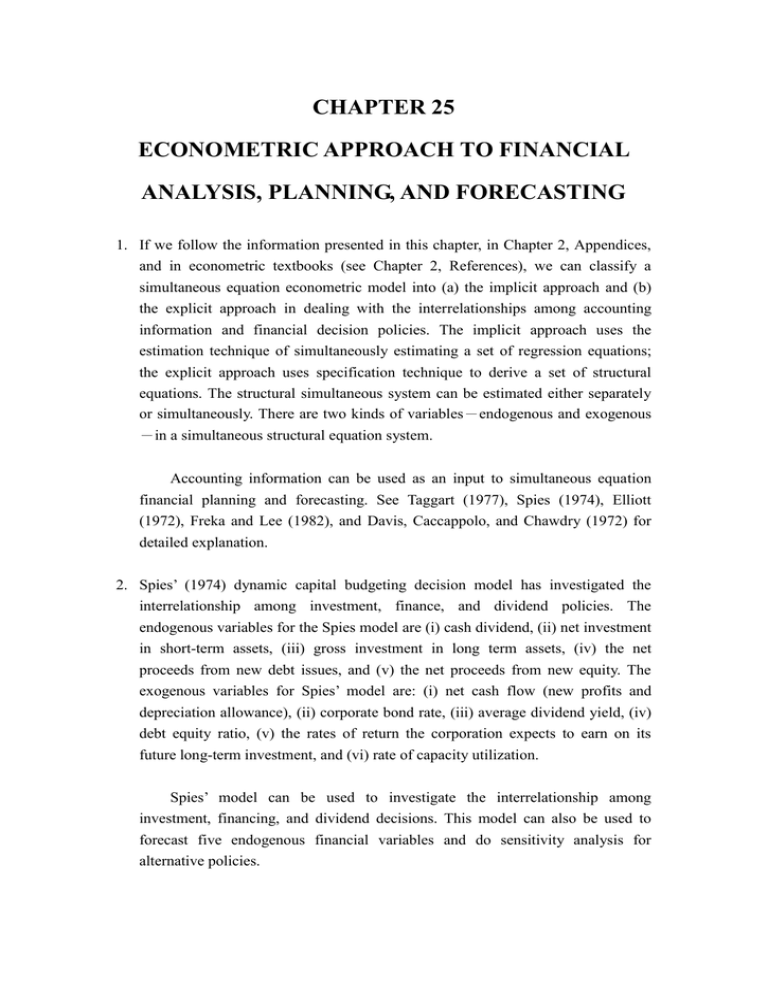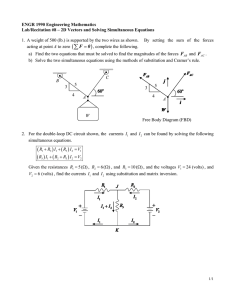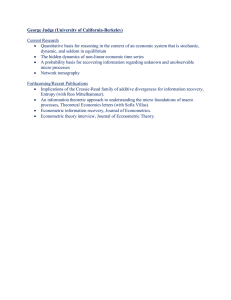25. Econometric Approach to Financial Analysis, Planning, and Forecasting
advertisement

CHAPTER 25 ECONOMETRIC APPROACH TO FINANCIAL ANALYSIS, PLANNING, AND FORECASTING 1. If we follow the information presented in this chapter, in Chapter 2, Appendices, and in econometric textbooks (see Chapter 2, References), we can classify a simultaneous equation econometric model into (a) the implicit approach and (b) the explicit approach in dealing with the interrelationships among accounting information and financial decision policies. The implicit approach uses the estimation technique of simultaneously estimating a set of regression equations; the explicit approach uses specification technique to derive a set of structural equations. The structural simultaneous system can be estimated either separately or simultaneously. There are two kinds of variables-endogenous and exogenous -in a simultaneous structural equation system. Accounting information can be used as an input to simultaneous equation financial planning and forecasting. See Taggart (1977), Spies (1974), Elliott (1972), Freka and Lee (1982), and Davis, Caccappolo, and Chawdry (1972) for detailed explanation. 2. Spies’ (1974) dynamic capital budgeting decision model has investigated the interrelationship among investment, finance, and dividend policies. The endogenous variables for the Spies model are (i) cash dividend, (ii) net investment in short-term assets, (iii) gross investment in long term assets, (iv) the net proceeds from new debt issues, and (v) the net proceeds from new equity. The exogenous variables for Spies’ model are: (i) net cash flow (new profits and depreciation allowance), (ii) corporate bond rate, (iii) average dividend yield, (iv) debt equity ratio, (v) the rates of return the corporation expects to earn on its future long-term investment, and (vi) rate of capacity utilization. Spies’ model can be used to investigate the interrelationship among investment, financing, and dividend decisions. This model can also be used to forecast five endogenous financial variables and do sensitivity analysis for alternative policies. 3. Since most of the accounting and financial variables are interrelated, the behavior equations of either financial and accounting variables can be jointly estimated by the SUR method to improve the efficiency of the parameters. The SUR method can be used to do asset pricing determination as discussed by Lee and Vinzo (1980) and determine the interrelationships of investment, financing, and dividends. 4. While under the programming approach (discussed in Chapter 22) the objective function is explicitly identified, under the simultaneous equations method the objective function is implicit from the set of equations. One thing that both the programming and simultaneous equations approaches ignore is the statistical properties of the variables used in the model. These two methods take the values as deterministic. This leads one to look at econometric models, which take variables as stochastic. Econometric models attempt to integrate single equation regression models and simultaneous equation models into a simultaneous equation system by (a) implicitly putting a set of equations together without a specific structural form, and (b) explicitly improving the specification to formulate a structural type of simultaneous equation system. In sum, the programming, simultaneous equations, and econometric approaches are three alternative modeling methods for financial analysis, planning, and forecasting. The relative empirical performance among these models in financial planning and forecasting is still to be investigated. 5. There are two alternative methods to set business policy decision: the quantitative method and the qualitative method. Financial planning and forecasting models can be used to do either simulation or sensitivity analysis to study the possible impacts of alternative business policies on the market value of a firm. See Duhaime and Thomas (1983) and others for further detailed information. This question offers the student a preliminary step to understand how long-term financial planning models can be inter-meshed with business policy decisions. However, detailed discussion of this type of subject is left to courses focused in business policy. 6. The model used in the empirical study was the regression model developed by Spies (1974). Following Eq. (25.A.6) of the text, the model is defined as X t BX t 1 CZt U t , (1) where X t is a 5 × 1 matrix with the following variables: X t (DIVt ISTt ILTt DFt EQFt ) ; Z t is a 6 × 1 matrix, which includes a constant (I) where Zt (1 Yt RDPt DELt Rt CUt ) ; B is a 5 × 5 matrix of coefficients and C is a 5 × 6 matrix of coefficients; U t is a 5 × 1 matrix which represents error terms. Tables 25.A.6(a) and 25.A.6(b) present the variable of DIV, IST, ILT, DF, EQF, Y, DEL, RDP, R, and CU. We can obtain X t and Z t from Tables 25.A.6(a) and 25.A.6(b). To obtain X t 1 , we can take lag one period values of Table 25.A.6(a). Regress X 1,t , X 2,t , X 3,t , X 4,t , X 5,t on X t 1 and Z t separately. Then we can get the results of Table 25.A.7(a). 7. There are two major methods to investigate the long-term financial analysis and planning of a firm. These two methods are linear-programming method, and simultaneous-equation method. In Chapter 22, we discussed that Carleton’s linear-programming model obtains an optimal solution to the wealth-maximization problem under a series of accounting constrains and firm policy constrains. In Chapter 23, we discussed two models, Warren and Shelton (1971) model and Francis and Rowell (1978) model, based upon the simultaneous-equation approach to financial planning. These two simultaneous-equation models are alternatives for linear-programming model. Mover, simultaneous-equation models are computer-based and easier for practitioners to use. In Chapter 25, we discussed how econometric techniques can be used as an important alternative for financial analysis, planning, and forecasting. The econometric approach can be classified as both the linear programming approach and the simultaneous-equation approach.



